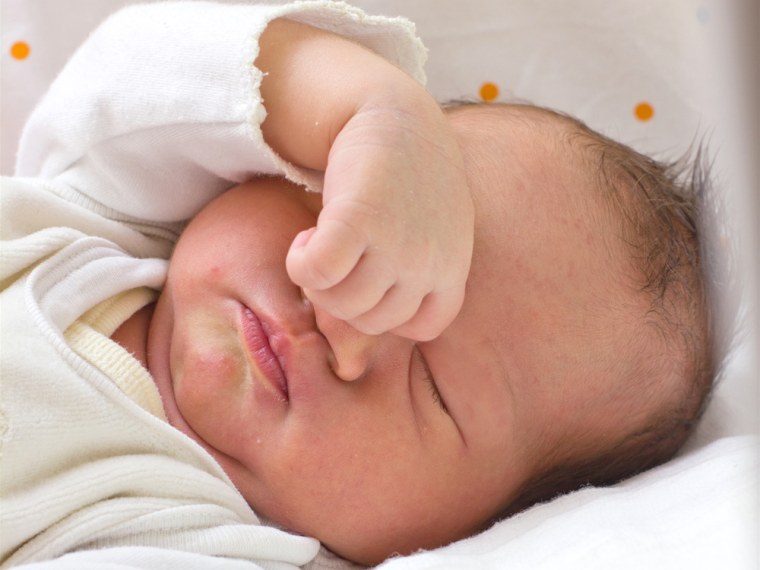Dr. Dana Gossett still remembers the unsettling and obsessive thoughts that filled her brain after her first child was born.
She worried that the baby would roll out of bed. She fretted repeatedly that she’d fall down the stairs while carrying her daughter, now a healthy 13-year-old.
“These are thoughts that come unbidden into your mind. They just appear there and can be uncomfortable,” recalls Gossett, chief of the obstetrics and gynecology division at the Northwestern University Feinberg School of Medicine.
“I had just enough psychiatry to know that this was not normal.”
Gossett’s scary thoughts stopped short of obsessive-compulsive disorder or OCD, but the idea that new moms might be particularly prone to symptoms of the psychological illness intrigued her.
Turns out, she was right. In new research released in the March/April issue of the Journal of Reproductive Medicine, Gossett and her colleagues report that new mothers are far more likely than others to report mild-to-moderate symptoms of OCD after childbirth.
In fact, they found that 11 percent of women reported significant obsessive-compulsive symptoms at two weeks and six months after childbirth. That compares with about 2 percent to 3 percent of people with symptoms in the general population, according to the study that is the first-large scale survey of post-partum OCD.
“We anticipated, just based on our anecdotal experience, that it would be higher than the 2 to 3 percent,” says Gossett. “But 11 percent was a surprisingly high number.”
The affected moms reported classic signs of OCD, including intrusive thoughts – fears about injuring the baby or worry about germs – and compulsive behaviors, such as checking repeatedly to be sure the baby was breathing, or washing and rewashing sterile bottles.
“What a compulsion is, is a ritualized behavior that in the mind of the person is going to allay their anxiety,” Gossett explains. “If I wash my hands 100 times, the baby won’t die.”
No one was clinically diagnosed with OCD, however. The study relied on surveys and self-reported data from 461 moms who weighed in at two weeks and 329 of them who provided more information at six months. Ninety-five percent of the moms had full-term babies; 55 percent had spontaneous vaginal deliveries and 37 percent were cesarean sections. Only about 8 percent of deliveries were emergencies and only about 8 percent of babies had to be hospitalized.
The good news is, in more than half of the mothers surveyed, the OCD symptoms went away by six months after childbirth. But in nearly half, the symptoms continued – and in about 5 percent of the moms affected, new symptoms developed.
Many new mothers develop signs of OCD in the early weeks after birth. Being obsessive and compulsive about caring for a newborn might actually be an appropriate psychological development, say Gossett and her co-author Dr. Emily Miller, a clinical fellow in maternal-fetal medicine.
Problems develop when the symptoms become severe and start interfering with daily life. A mom whose mind is filled with terrible thoughts of drowning the baby might avoid baths entirely, for instance. Another mom might spend so much time checking to be sure the child is breathing that she can’t complete other tasks.
“It really comes down to function,” Gossett says. “If it’s causing significant emotional distress or if it’s preventing her from caring for herself or the child.”
The researchers aren’t clear what exactly triggers the OCD symptoms in new moms. It could be a biological effect, perhaps related to dramatic hormone swings after delivery, Gossett and Miller say.
About 70 percent of women in the study with OCD symptoms also suffered from depression. There’s some debate in the field about whether postpartum depression is just depression that happens after pregnancy or a separate disease entirely, Miller says.
“Our new study supports the idea that it may be its own disease with more of the anxiety and obsessive compulsive symptoms that would be typical for a major depressive episode,” she says.
But an OCD and anxiety expert not affiliated with the study says he believes postpartum OCD also may be a psychological overreaction to the shift in responsibility that comes with having a newborn.
“You go from being relatively carefree and now you have this tiny little infant and you’re so responsible. It’s all on you,” says Jon Abramowitz, a professor and associate chairman of the department of psychology at the University of North Carolina at Chapel Hill. For more information about OCD, click here.
New parenthood is a common trigger for development of OCD symptoms – and of full-blown clinical disease, says Abramowitz, who adds that his own research shows that new dads may be affected, too.
The good news is that postpartum OCD can be treated, Abramowitz says. Educating new parents to understand that everyone has strange or distressing thoughts after childbirth and providing access to therapy that addresses the thoughts and behaviors if they become a problem can help.
“We all sometimes get anxious,” he says. “Part of the therapy is how not to let it get in the way of your life.”
Related stories:
